Physical Address
304 North Cardinal St.
Dorchester Center, MA 02124
Ultrasound is well suited for evaluation of the pediatric pelvis by providing excellent image quality without the use of radiation or the routine use of contrast material and without the need for sedation or anesthesia.
Sonography of the pelvis is an excellent modality for serial assessment of pediatric pelvic abnormalities.
Ultrasound can be used to evaluate congenital, infectious, inflammatory, endocrine, and neoplastic abnormalities of the pediatric pelvis.
The appearance of the gonads of both sexes undergoes changes throughout the pediatric age range as they grow and develop adult characteristics.
Water can be used as a contrast agent to distend structures that are normally collapsed (e.g., bladder, ureter, vagina, rectum) to facilitate evaluation and diagnosis.
Although transvaginal ultrasound (TVS) provides high-resolution imaging of the female pelvis, its use in most pediatric female patients is precluded because they are not sexually active.
High-resolution, real-time, gray-scale and color Doppler sonography has emerged as the modality of choice for the evaluation of the pelvis in infants, children, and adolescents. Using the distended bladder as an acoustic window, the lower urinary tract, uterus, adnexa, prostate gland, seminal vesicles, and pelvic musculature and vessels can be easily evaluated.
Depending on the size of the child, a 5-2, 9-4, or 8-5 MHz real-time curvilinear broad-bandwidth or sector transducer is used to obtain scans, usually in the transverse and sagittal planes. Linear probe technology is useful for evaluation of the bowel, peritoneum, perineum, and superficial lesions using a 12-5 MHz, 17-5 MHz, or other high-frequency linear broad-bandwidth probes.
Patients should be well hydrated before pelvic sonography so that the bladder will be optimally filled. In infants and young children who are unable to maintain a full bladder despite drinking clear liquids, it may be necessary to catheterize and fill the bladder with sterile water through a 5- or 8-French feeding tube, although this is rarely necessary. The use of sterile water as a contrast agent to outline the vagina (hydrosonovaginography) ( Fig. 54.1 , ), rectum (water enema) ( Fig. 54.2 ), or urogenital sinus may be very helpful in the evaluation of the pediatric patient with a pelvic mass or complex congenital anomalies of the genitourinary tract. Meticulous real-time scanning is essential because these structures are filled in a retrograde manner. When transabdominal sonography (TAS) provides suboptimal images in mature, sexually active teenage girls, transvaginal ultrasound (TVS) can provide higher resolution with more detailed images, thus aiding in the elucidation of the origin and characteristics of pelvic masses and complex adnexal lesions.
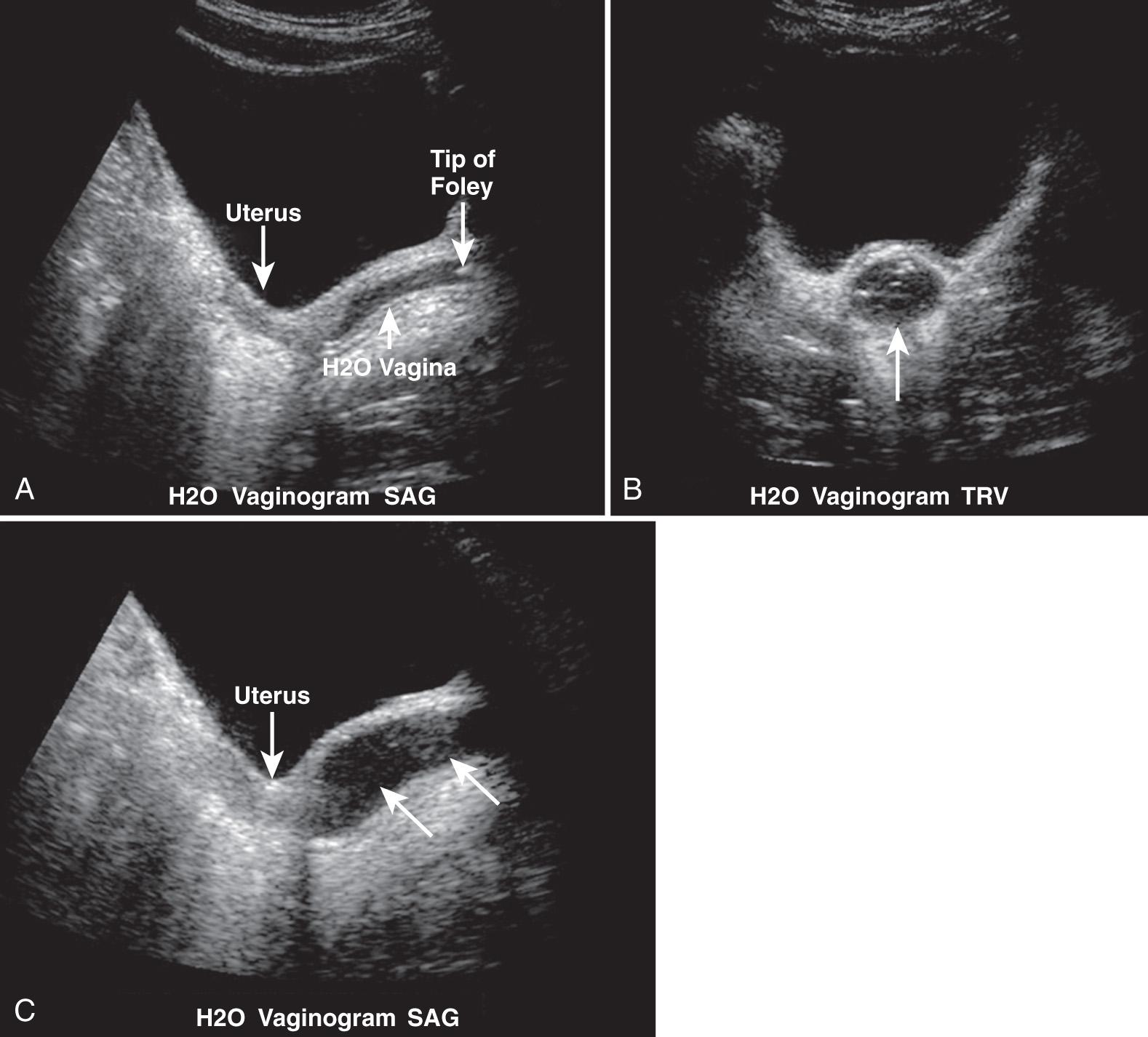
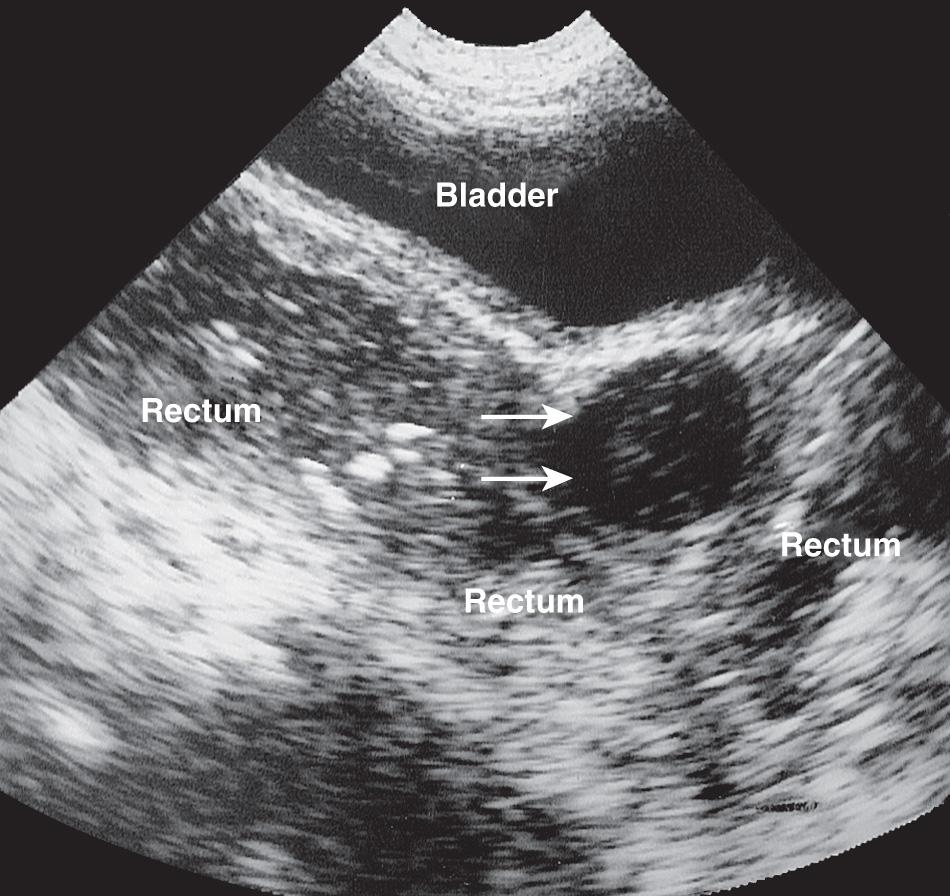
The wall of the urinary bladder should be smooth in a distended state, with the wall thickness not greater than 3 mm during bladder distention, with a mean of 1.5 mm. The wall should not be greater than 5 mm thick with the bladder empty or partially distended. In the nondistended state the internal aspect of the bladder wall generally appears slightly irregular sonographically. A urachal remnant may be visualized on sonography, as a structure of variable form and size, lying ventral to the peritoneum and situated between the umbilicus and the apex of the urinary bladder. The distal ureters, with the exception of the submucosal intravesical portion, are not usually visualized unless abnormally dilated. The trigone, however, is easily demonstrated ( Fig. 54.3 ). The bladder neck and urethra can be demonstrated in both males and females by angling the transducer inferiorly ( Fig. 54.4 ). If a urethral abnormality is noted on suprapubic imaging, scans through the perineum or transrectally can confirm these findings using a different imaging plane.
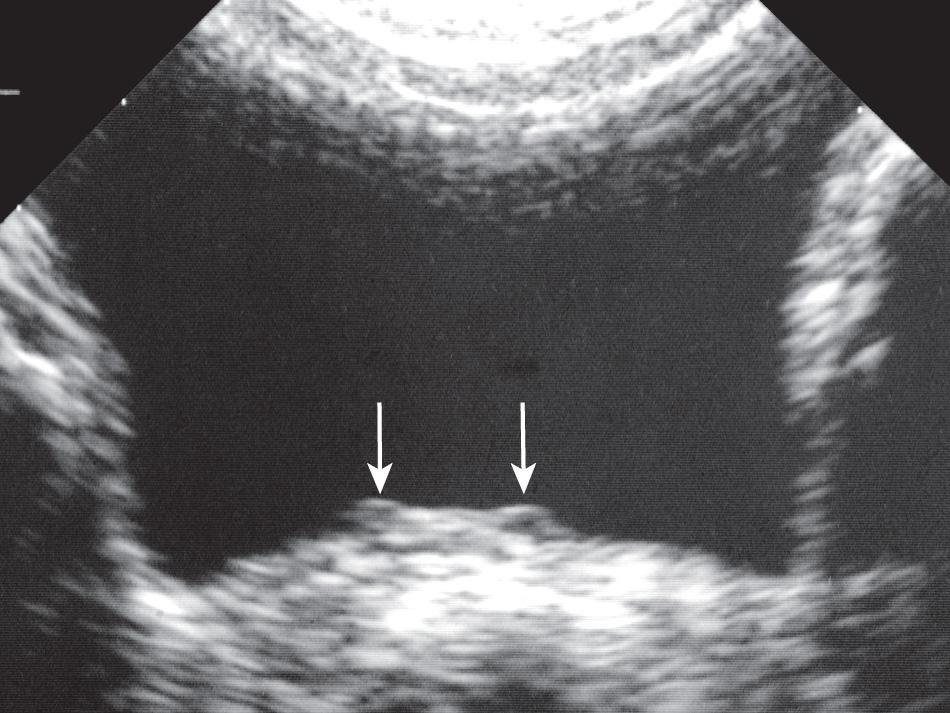
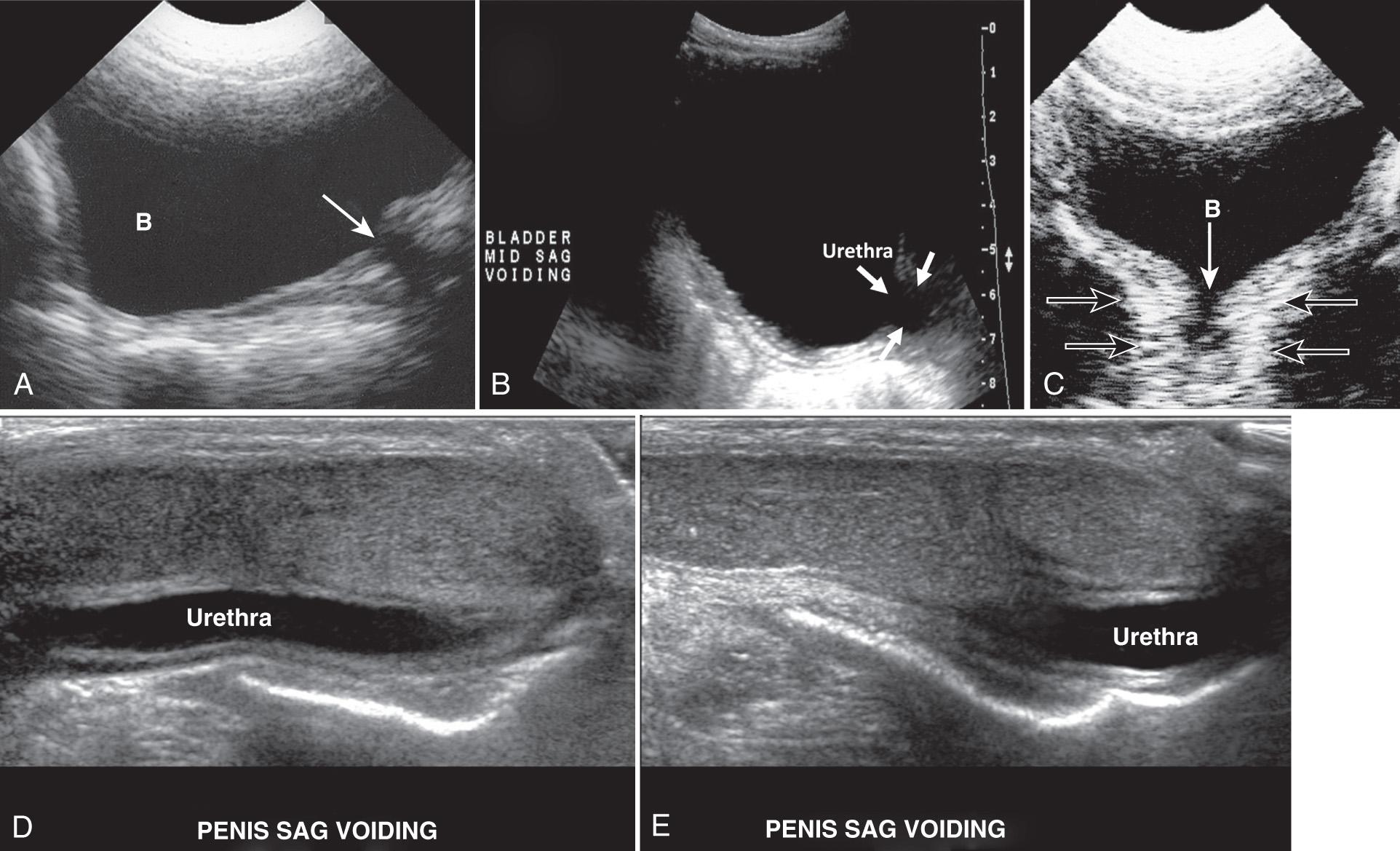
Hydrosonourethrography may be used to detect anterior urethral abnormalities (strictures, calculi, anterior or posterior urethral valves, foreign bodies, bladder neck dyssynergia, diverticula, trauma) by scanning the penis with a linear array transducer during real-time observation during voiding or during a retrograde hand-injection of saline into the urethra. Postvoid scanning of the bladder can provide information about bladder function, differentiate the bladder from cystic masses or fluid collections in the pelvis, and evaluate the degree of drainage from dilated upper urinary tracts. When children cannot void, films taken after a Credé maneuver or catheterization indicate the effectiveness of these bladder-emptying procedures. We measure the postvoid residual of the bladder using the following formula:
The uterus and ovaries undergo a series of changes in size and configuration during normal growth and development. The newborn female uterus is prominent and thickened with a brightly echogenic endometrial lining caused by in utero hormonal stimulation ( Fig. 54.5 ). In the first 3 days of life, mean length and mean volume of the uterus are 4.2 cm and 10.0 cm 3 . The uterine configuration is spade shaped with a fundus-to-cervix ratio of 1 : 2. At 2 to 3 months of age the prepubertal uterus regresses to a smaller size and flat configuration ( Fig. 54.6 ), with a length of 2.5 to 3 cm and a fundus-to-cervix ratio of 1 : 1, and with the endometrial stripe (when seen) appearing as thin as a pencil line. This tubular uterine configuration is maintained until puberty. The postpubertal uterine length gradually increases to 5 to 7 cm, and the fundus-to-cervix ratio becomes 3 : 1 ( Table 54.1 ). The echogenicity and thickness of the endometrial lining then vary according to the phase of the menstrual cycle, as in adult women. The uterus is supplied by bilateral uterine arteries, which are branches of the internal iliac arteries. Color Doppler imaging generally demonstrates flow in the myometrium, with little or no flow in the endometrium.
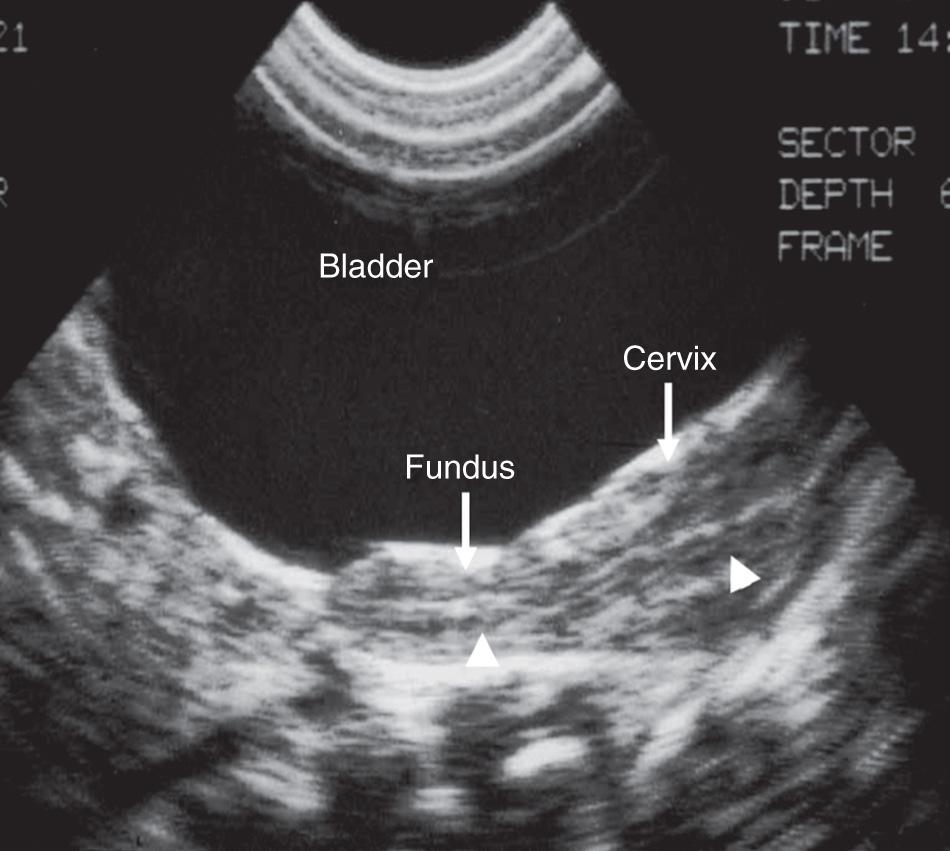
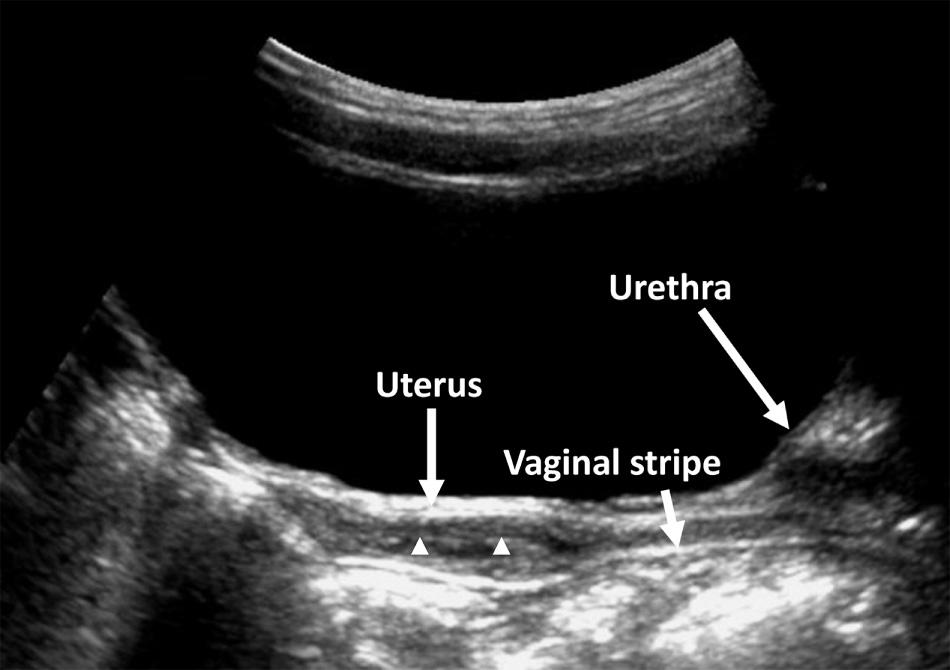
| Age | Uterine Length | Fundus-to-Cervix Ratio |
|---|---|---|
| Newborn | 3.5 cm | 1 : 2 |
| Prepubertal a | 2.5-3 cm | 1 : 1 |
| Postpubertal | 5-8 cm | 3 : 1 |
In children, digital and visual examination of the vagina is difficult. Often, physical examination of the vagina is performed with the patient under general anesthesia. High-resolution, real-time sonography can now obviate this need in many cases. In the infant or young girl with an interlabial mass, sonography in conjunction with other imaging modalities can usually determine the cause. The vagina is best visualized on midline longitudinal scans through the distended bladder. It appears as a long, tubular structure in continuity with the uterine cervix. The apposed mucosal surfaces cause a long, bright, slender, central linear echo. Hydrosonovaginography (see Fig. 54.1 ) under real-time sonography guidance can provide additional information about vaginal patency or confirm the presence or absence of a vaginal mass.
Sonographic visualization of the ovaries in children can vary, depending on their location, size, and the age of the patient ( Fig. 54.7 , ). Because of a typically long pedicle and a small pelvis, the neonatal ovaries may be found anywhere between the lower pole of the kidneys and the true pelvis ( Fig. 54.8 ). Ovarian size is most reproducible and best described by measurement of the ovarian volume, which is calculated by a prolate ellipse formula (Length × Depth × Width [in cm] × 0.523 = Volume [in mL]).
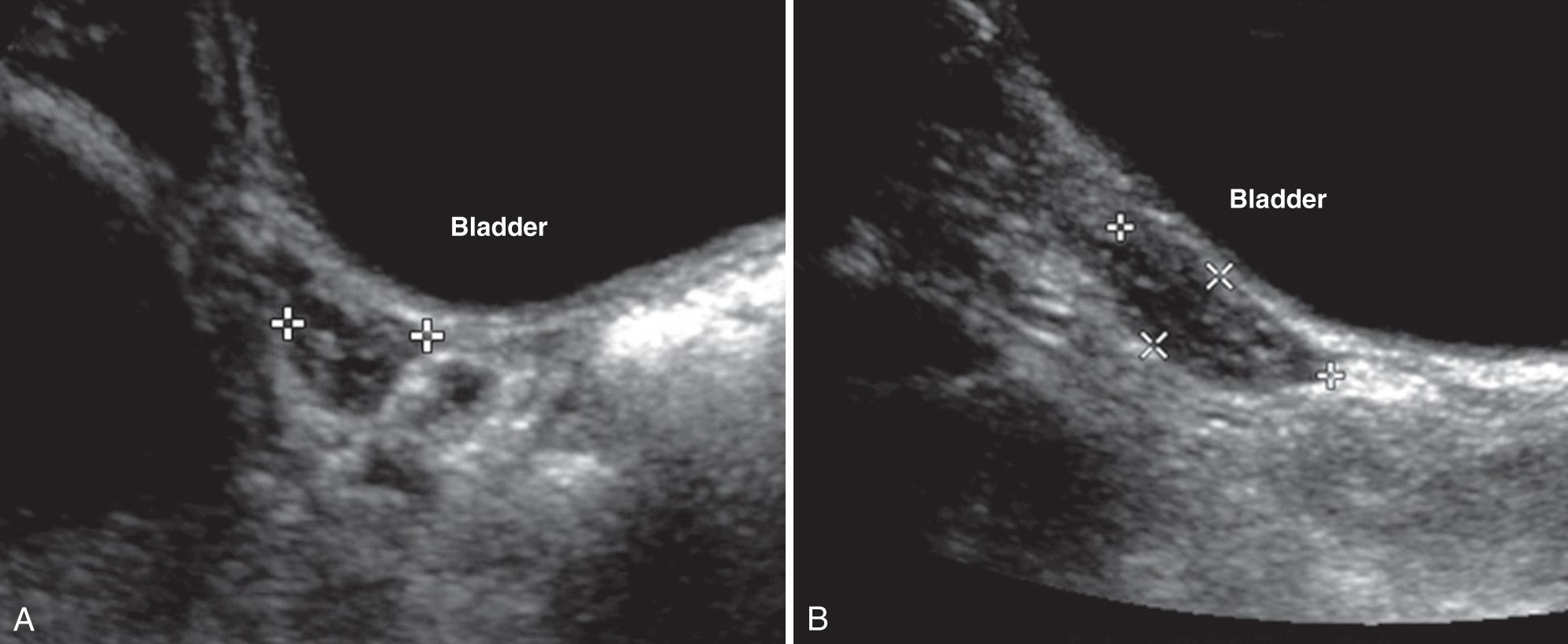
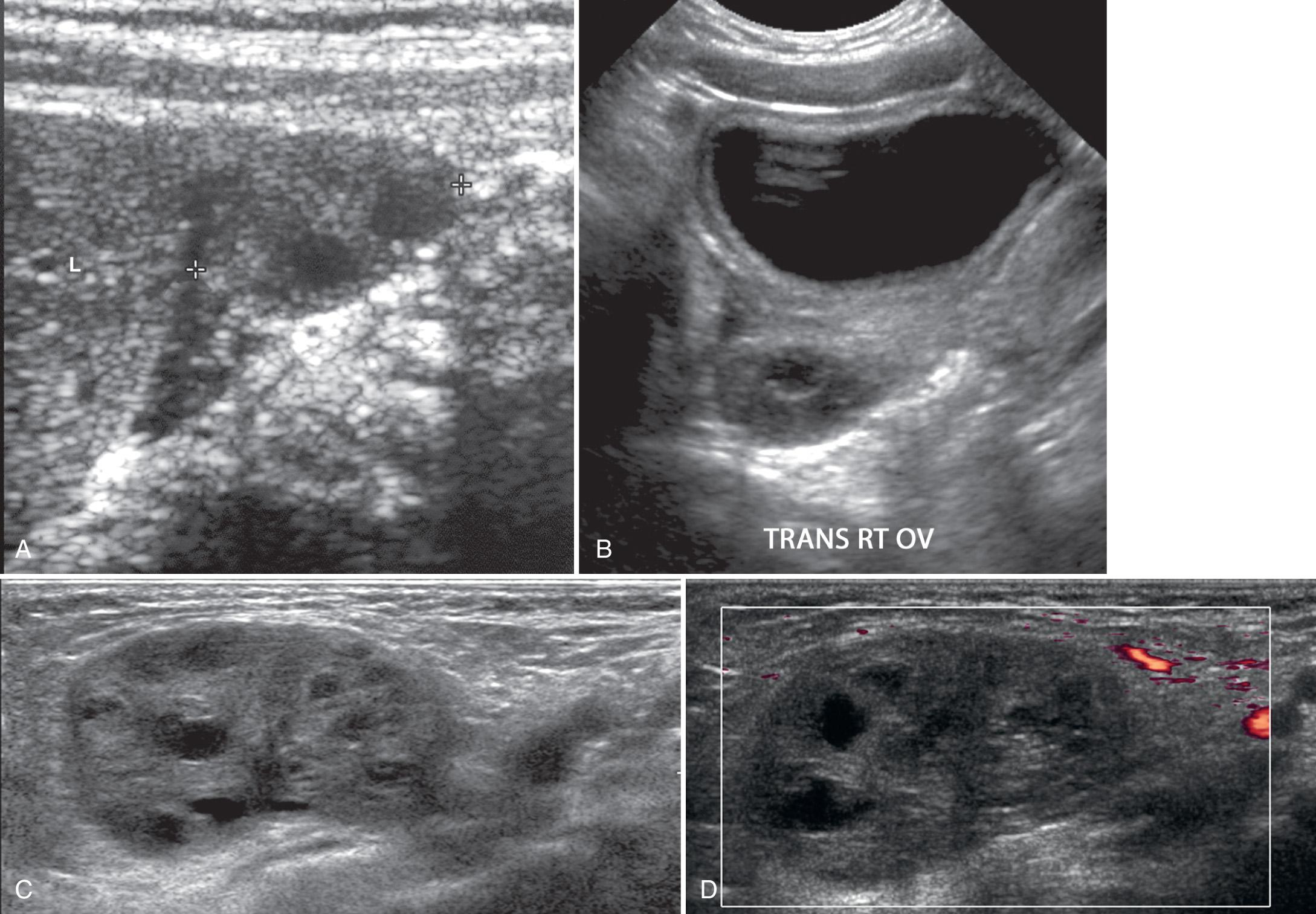
The mean ovarian volume in neonates and girls younger than 6 years is usually 1 mL or less. Ovarian volume gradually begins to increase at about age 6 years. The mean ovarian volume measurement in premenarchal girls aged 6 to 11 years ranges from 1.2 to 2.5 mL ( Table 54.2 ). There is marked enlargement in ovarian size after puberty; thus ovarian sizes in menstruating females in late childhood will be larger than their premenarchal counterparts. Cohen and colleagues reported a mean ovarian volume of 9.8 mL, with a 95% confidence interval between 2.5 and 21.9 mL, in menstruating females.
| Age | Mean Ovarian Volume, mL (±SD) |
|---|---|
| PREMENARCHAL | |
| 0-5 yr | ≤1 mL |
| 1 day to 3 mo | 1.06 (±0.96) |
| 4-12 mo | 1.05 (±0.67) |
| 13-24 mo | 0.67 (±0.35) |
| 3 yr | 0.7 (±0.4) |
| 4 yr | 0.8 (±0.4) |
| 5 yr | 0.9 (±0.02) |
| 6-8 yr | 1.2 mL |
| 6 yr | 1.2 (±0.4) |
| 7 yr | 1.3 (±0.6) |
| 8 yr | 1.1 (±0.5) |
| 9-10 yr a | 2.1 mL |
| 9 yr | 2.0 (±0.8) |
| 10 yr | 2.2 (±0.7) |
| 11 yr a | 2.5 mL (±1.3) |
| 12 yr a | 3.8 mL (±1.4) |
| 13 yr a | 4.2 mL (±2.3) |
| MENSTRUAL | |
| 9.8 mL (±5.8) | |
a Note that these measurements may differ, depending on degree of maturation and presence of menarche.
Beginning in the neonatal period, the appearance of the typical ovary is heterogeneous secondary to small cysts. Cohen and colleagues reported observing ovarian cysts in 84% of children 1 day to 2 years of age and 68% of children 2 to 12 years of age. Macrocysts (>9 mm) were more frequently seen in the ovaries of girls in their first year of life compared with those in their second year. This probably accounts for the larger mean and top-normal ovarian volume measurements obtained in girls up to 3 months of age (mean ovarian volume, 1.06 mL; range, 0.7-3.6 mL) versus those 13 to 24 months of age (mean ovarian volume, 0.67 mL; range, 0.1-1.7 mL). These findings probably result from the higher residual maternal hormone level in younger infants. Orbak and colleagues concluded that ovarian volume was reduced in newborns with relatively low birth weight and intrauterine growth restriction, and that functional cysts were more prevalent among low-birth-weight girls.
The blood supply of the ovary is dual, arising from the ovarian artery, which originates directly from the aorta, and from the uterine artery, which supplies an adnexal branch to each ovary. Blood flow can be seen in 90% of the adolescent ovary, but Doppler imaging cannot distinguish between the two blood supplies. Typically, on color Doppler imaging the intraovarian arteries appear as short, straight branches located centrally within the normal ovary.
Simple ovarian cysts in children are relatively common. Small cysts (1-7 mm) have been detected on sonograms in the third-trimester fetus and the neonate and are secondary to maternal and placental chorionic gonadotropin. There is a higher incidence of larger ovarian cysts in infants of mothers with toxemia, diabetes, and Rh isoimmunization, all of which are associated with a greater-than-normal release of placental chorionic gonadotropin. Large ovarian cysts in the fetus can cause mechanical complications during vaginal delivery. As a result of the small size of the true pelvis in infants and young children, ovarian cysts are often intraabdominal in location and must be differentiated from mesenteric or omental cysts, gastrointestinal duplication cysts, and urachal cysts. Ovarian cysts are associated with cystic fibrosis, congenital juvenile hypothyroidism, McCune-Albright syndrome (fibrous dysplasia and patchy cutaneous pigmentation), and peripheral sexual precocity. Autonomously functioning ovarian cysts can cause precocious pseudopuberty.
Although neonatal ovarian cysts were surgically removed in the past, spontaneous resolution of some cysts has been demonstrated on sonography ( Fig. 54.9 ). When a follicle continues to grow after failed ovulation or when it does not collapse after ovulation, follicular and corpus luteal cysts may result. Most follicular cysts are unilocular, contain clear serous fluid, and range in size from 3 to 20 cm. Corpus luteal cysts can contain serous or hemorrhagic fluid and generally range in size from 5 to 11 cm. Theca lutein cysts are thought to represent hyperstimulated follicles caused by gestational trophoblastic disease or a complication of drug therapy to stimulate ovulation. Rarely, parovarian cysts are diagnosed in childhood ( Fig. 54.10 ). They are of mesothelial or paramesonephric origin and arise in the broad ligament or fallopian tubes.
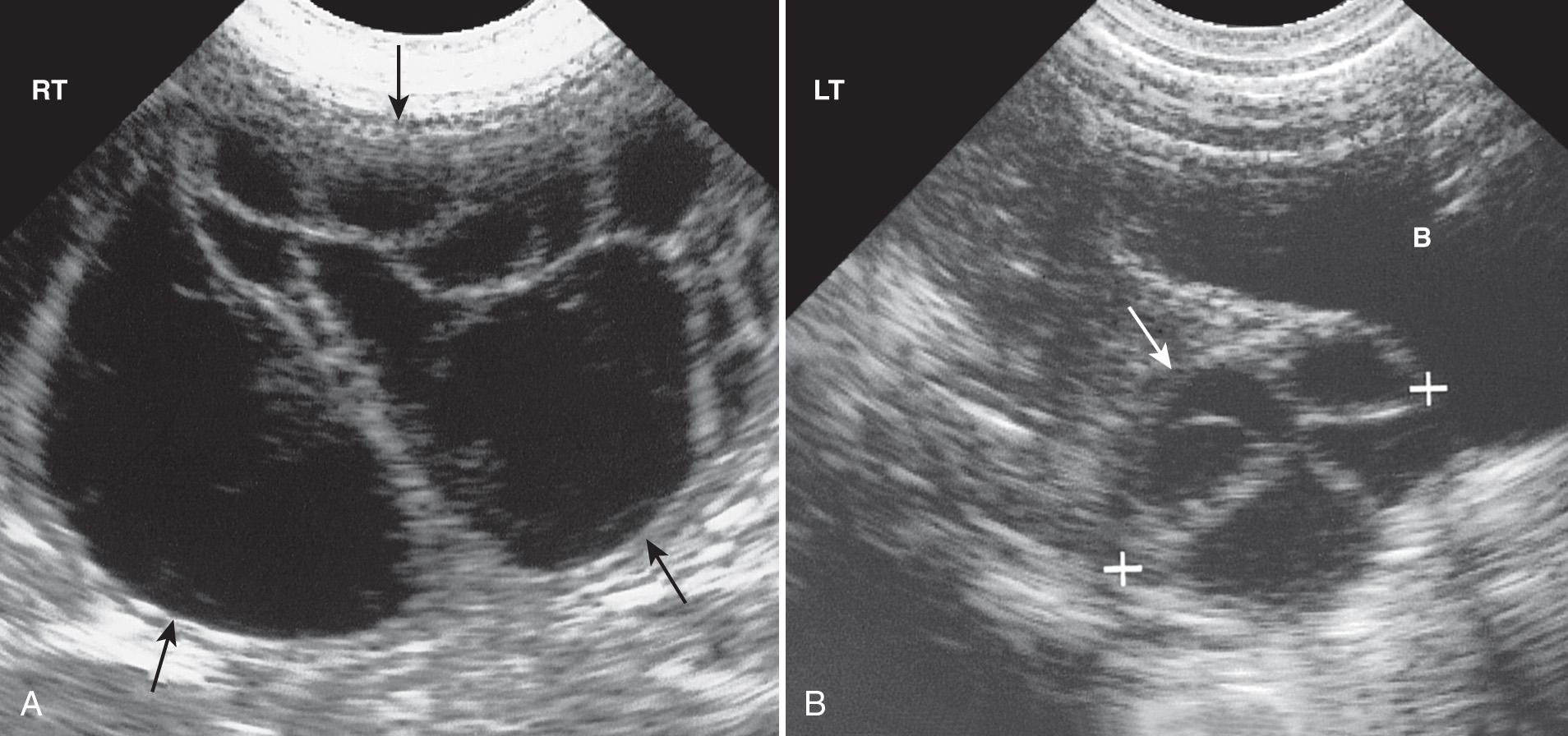
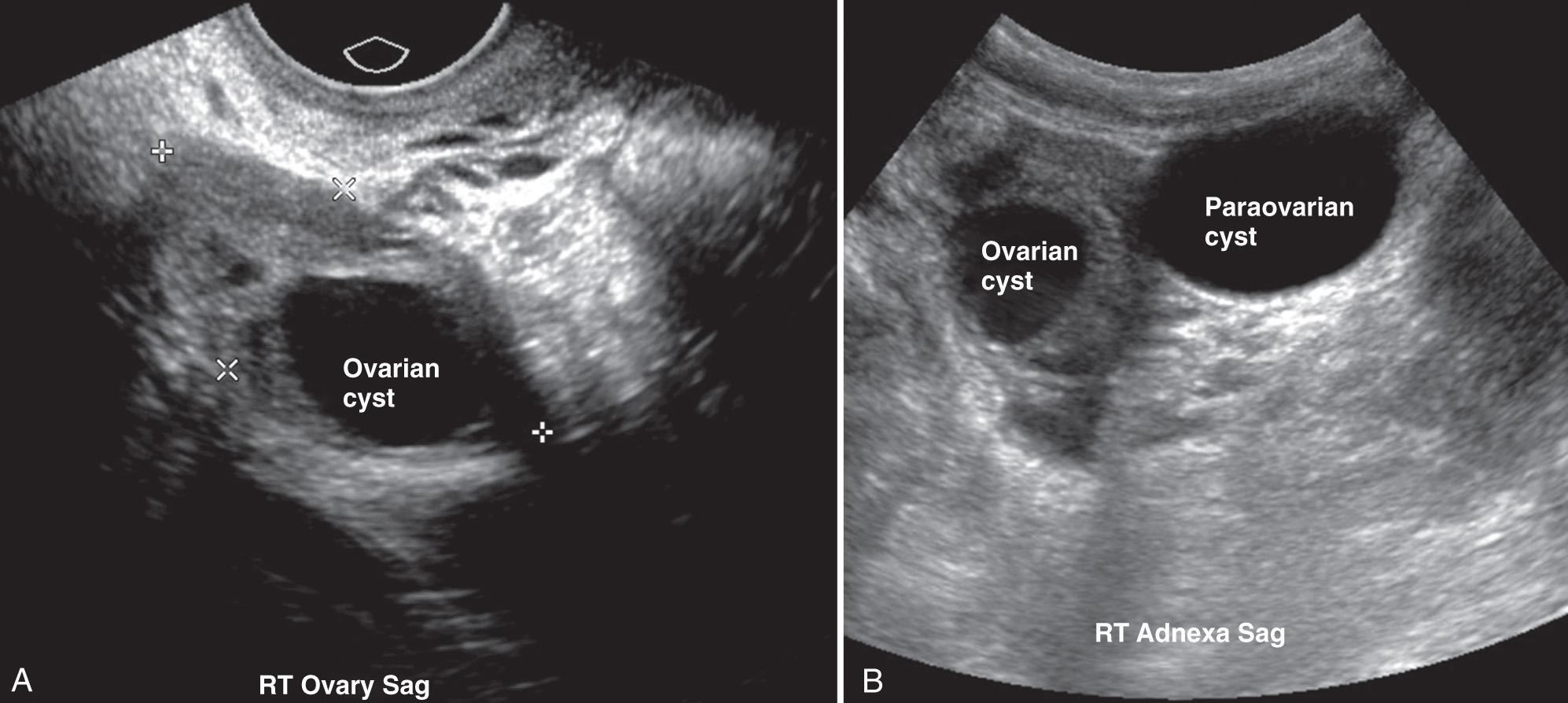
Most ovarian cysts are asymptomatic. Symptoms of pain, tenderness, nausea, vomiting, and low-grade fever usually indicate complications of torsion, hemorrhage, or rupture. Torsion can occur in normal ovaries but is more often caused by an ovarian cyst or tumor. In children, torsion of the normal ovary can occur because the fallopian tube is relatively long and the ovary is more mobile. The typical presentation is sudden onset of acute lower abdominal pain, often associated with nausea, vomiting, and leukocytosis. Torsion of normal adnexa usually occurs in prepubertal girls and is thought to be related to excessive mobility of the adnexa, allowing torsion at the mesosalpinx with changes in intraabdominal pressure or body position. Torsion of the ovary and fallopian tube results from partial or complete rotation of the ovary on its vascular pedicle. This results in compromise of arterial and venous flow, congestion of the ovarian parenchyma, and, ultimately, hemorrhagic infarction. The sonographic findings in acute ovarian torsion are often nonspecific and include ovarian enlargement, fluid in the cul-de-sac, and other adnexal pathologic findings, such as cyst or tumor ( Fig. 54.11 and see Fig. 54.8C-D ). A predominantly cystic or complex adnexal mass with a fluid-debris level or septa correlates with pathologic evidence of ovarian hemorrhage or infarction. In 28 of 32 patients, Lee and colleagues showed that ultrasound could demonstrate preoperatively the twisted vascular pedicle in surgically proven torsion, giving a diagnostic accuracy of 87%. This appeared as a round, hyperechoic structure with multiple concentric hypoechoic stripes (target appearance), as a beaked structure with concentric hypoechoic stripes, or as an ellipsoid or tubular structure with internal heterogeneous echoes. Concentric hypoechoic intrapedicular structures could be identified as vascular structures on color Doppler sonography (“whirlpool sign”). The absence of flow on color Doppler ultrasound is not a reliable diagnostic criterion because peripheral (or even central) arterial flow can be seen in surgically proven twisted ovaries. This may be explained by the duality of the ovarian arterial perfusion. The demonstration of multiple follicles (8-12 mm in size) in the cortical or peripheral portion of a unilaterally enlarged ovary has been reported as a specific sonographic sign of torsion. These cystic changes occur in up to 74% of twisted ovaries and are attributed to transudation of fluid into follicles secondary to vascular congestion. At times, isolated fallopian tube torsion occurs in perimenarcheal girls with acute pelvic pain and in whom a cystic mass in a midline position is demonstrated (either in the cul-de-sac or superior to the uterus) in association with a normal ipsilateral ovary.
Ovarian enlargement
Fluid in cul-de-sac
Adnexal mass (ovarian hemorrhage or infarction)
Cystic or complex
Fluid-debris level
Multiple peripheral follicles
“Whirlpool sign” on color Doppler
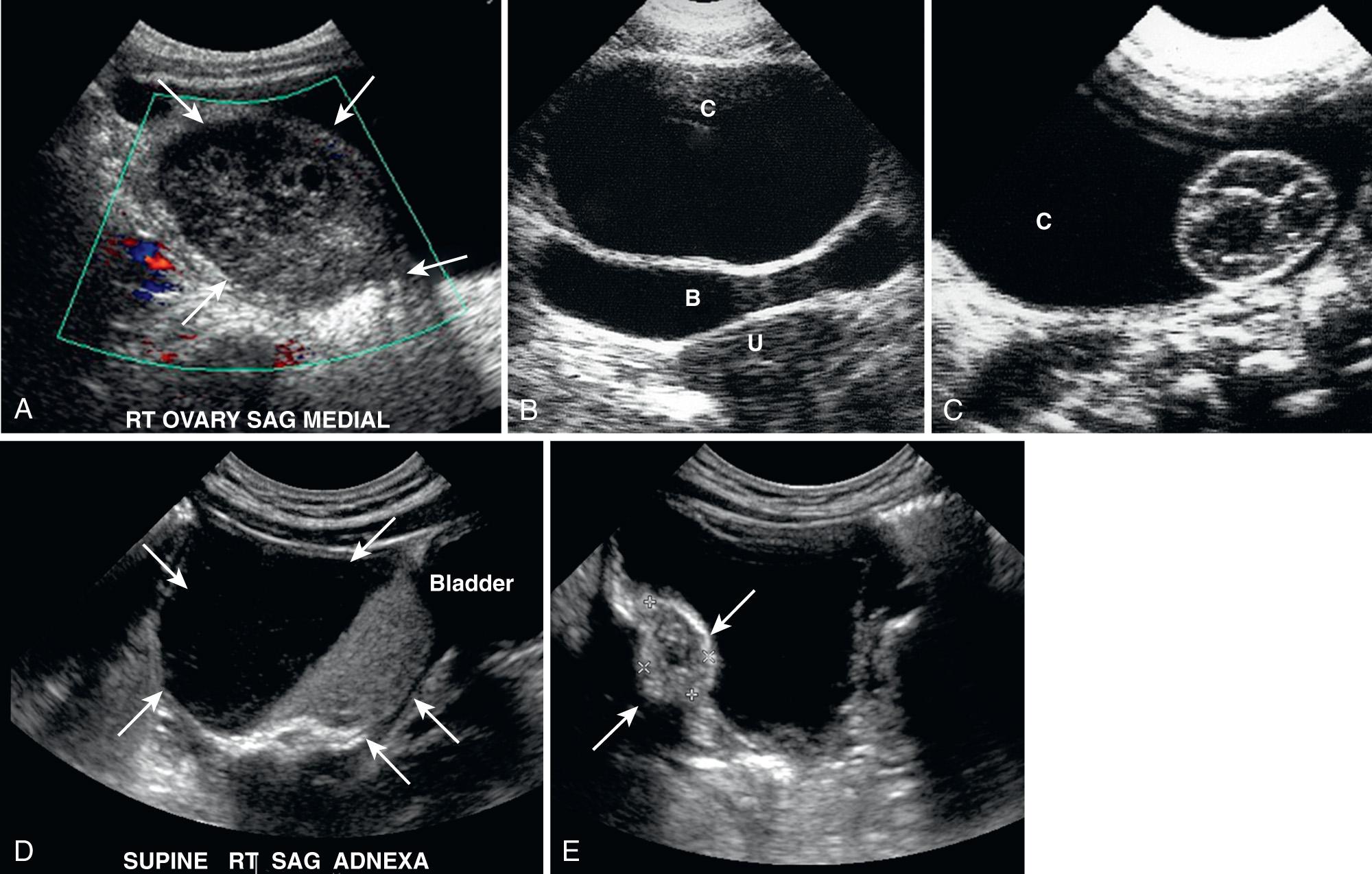
Hemorrhagic ovarian cysts occur in adolescents and have a variety of sonographic patterns caused by internal blood clot formation and lysis ( Fig. 54.12 ). The most common appearance is a heterogeneous mass that is predominantly anechoic and contains hypoechoic material. Less often, hemorrhagic ovarian cysts are homogeneous, either hypoechoic or hyperechoic. Almost all hemorrhagic cysts (92%) have increased sound through transmission, indicating the cystic nature of the lesion. Additional sonographic features include a thick wall (e.g., 4 mm), septations, and fluid in the cul-de-sac. Although the sonographic findings are nonspecific, the changing appearance of hemorrhagic ovarian cysts over time, as a result of clot lysis, can help establish the diagnosis. In some cases the diagnosis can be confused with appendiceal abscess, dermoid cyst, or teratoma. Rarely, pelvic varices can masquerade as a multiseptated cystic mass ( Fig. 54.13 ).
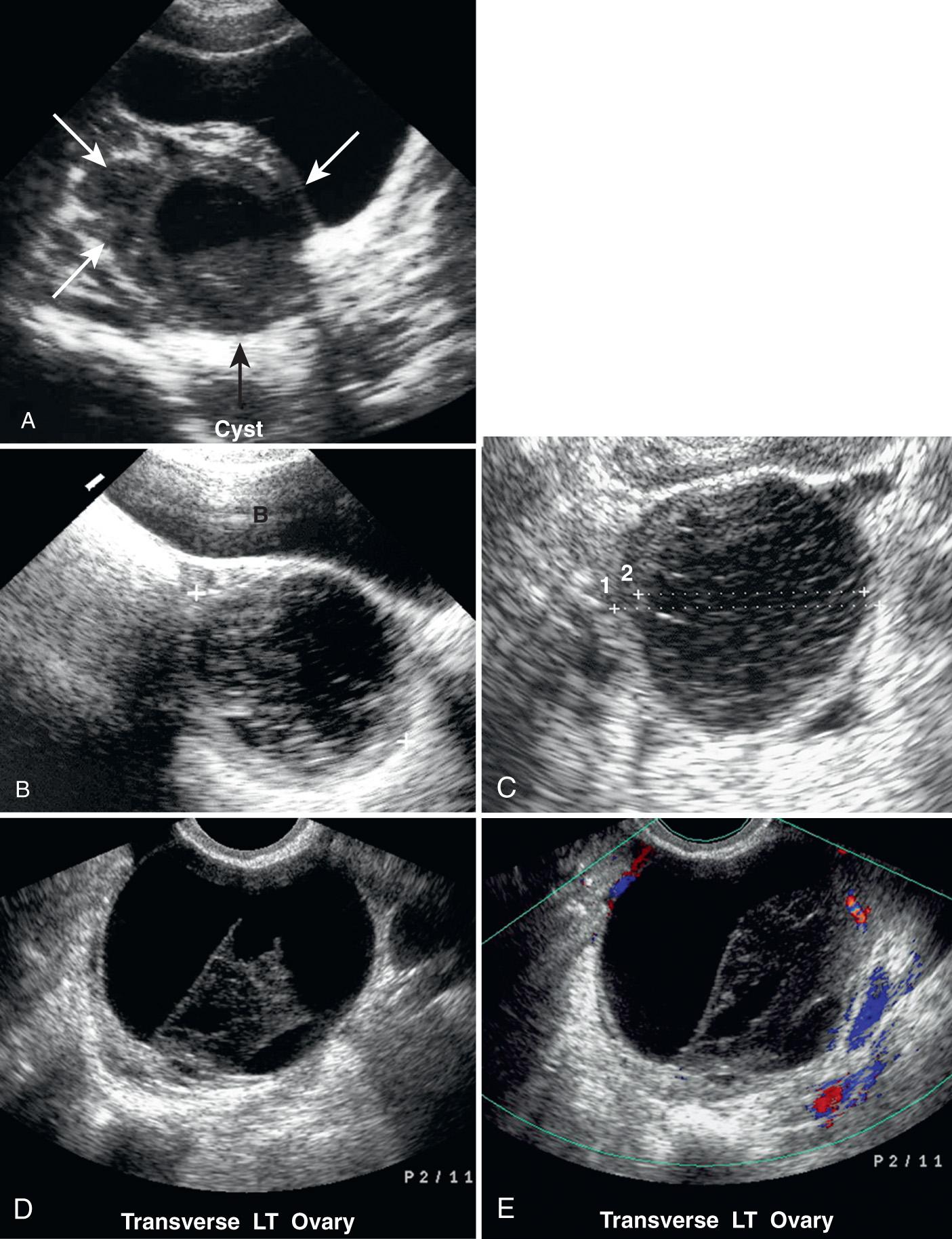
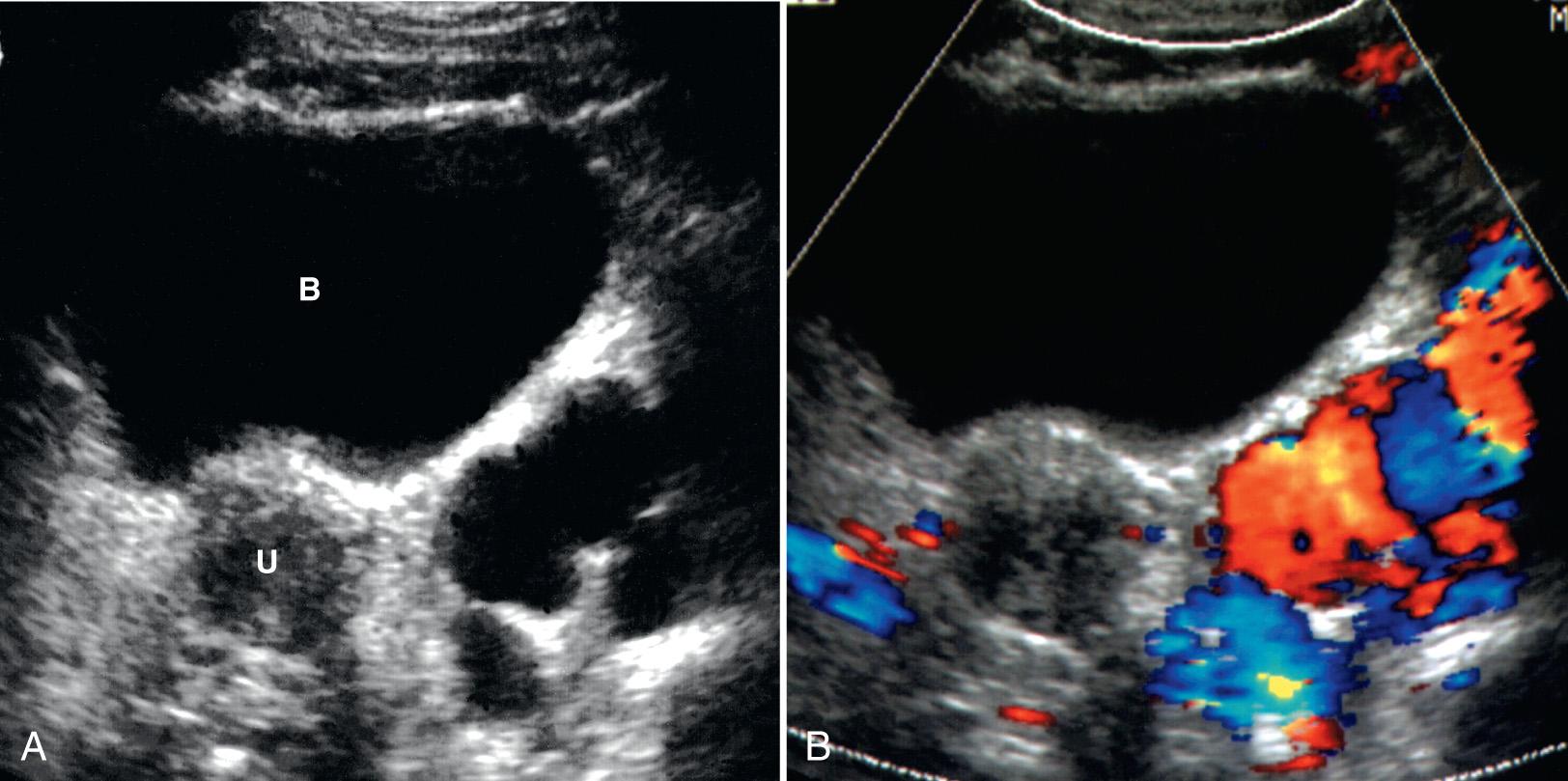
The primary clinical manifestations of polycystic ovarian disease (polycystic ovary syndrome [PCOS], Stein-Leventhal syndrome) are hirsutism and irregular menstrual bleeding caused by excess ovarian androgens and chronic anovulation. These features emerge late in puberty or shortly thereafter. In patients with obesity or insulin resistance, the severity of the presentation is amplified. The evolution of this condition during early adolescence is not well understood, but it appears that abnormal activation of the hypothalamic-pituitary-ovarian-adrenal axis occurs, accompanied by specific morphologic changes in the ovaries. The changes in the ovaries have been termed “polycystic ovarian morphology.” It was defined in adults by the Rotterdam criteria as (a) one or both ovaries demonstrate 12 or more follicles measuring 2 to 9 mm in diameter, or (b) the ovarian volume exceeds 10 cm ( Fig. 54.14 , ). However, there is controversy as to whether the same criteria can be applied to adolescents. These criteria are based on TVS in adults. In the adolescents, sonography is predominately performed transabdominally. The transabdominal approach has decreased resolution compared with TVS, which can limit evaluation of follicle number, especially in obese patients. However, sonography is still valuable and frequently is used in the evaluation of an adolescent girl suspected of having PCOS. Long-term follow-up is important in these patients because of the increased incidence of endometrial carcinoma from long-term unopposed estrogen.
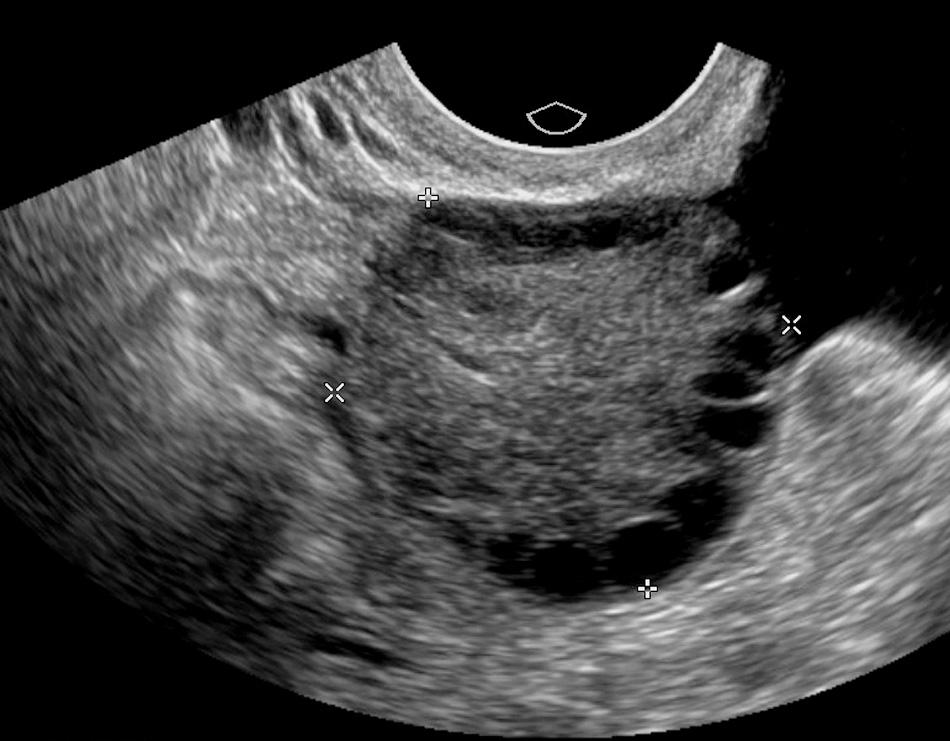
Massive edema of the ovary manifests with marked enlargement of the affected ovary caused by accumulation of edema fluid in the stroma, separating normal follicular structures ( Fig. 54.15 ). It is thought to result from partial or intermittent torsion that interferes with venous and lymphatic drainage. It affects patients during their second to third decades of life and causes acute abdominal pain, palpable adnexal mass, menstrual disturbances at times, masculinization, and Meigs syndrome. Two-thirds of patients have right-sided ovarian edema, thought to be related to high pressure in the right ovarian vein caused by direct drainage into the inferior vena cava (IVC) or increased pressure secondary to uterine dextroposition. The ovaries may be massively enlarged, with diameter up to 35 cm. Grossly, the external surface is soft and pearly white and appears similar to fibromatosis, a condition likely to occur in young women (up to 25 years of age) in which primary proliferation of the ovarian stroma may result in torsion and ultimately edema. The sonographic features of ovarian edema include a solid, hypoechoic mass, enhanced through transmission, and cystic follicles within the lesion. The masculinization is thought to be caused by stromal luteinization that results from mechanical stretching of the stromal cells by the edema fluid. In addition, human chorionic gonadotropin–like substance may accumulate in edema fluid and promote luteinization, and level of 17-ketosteroids may be increased.
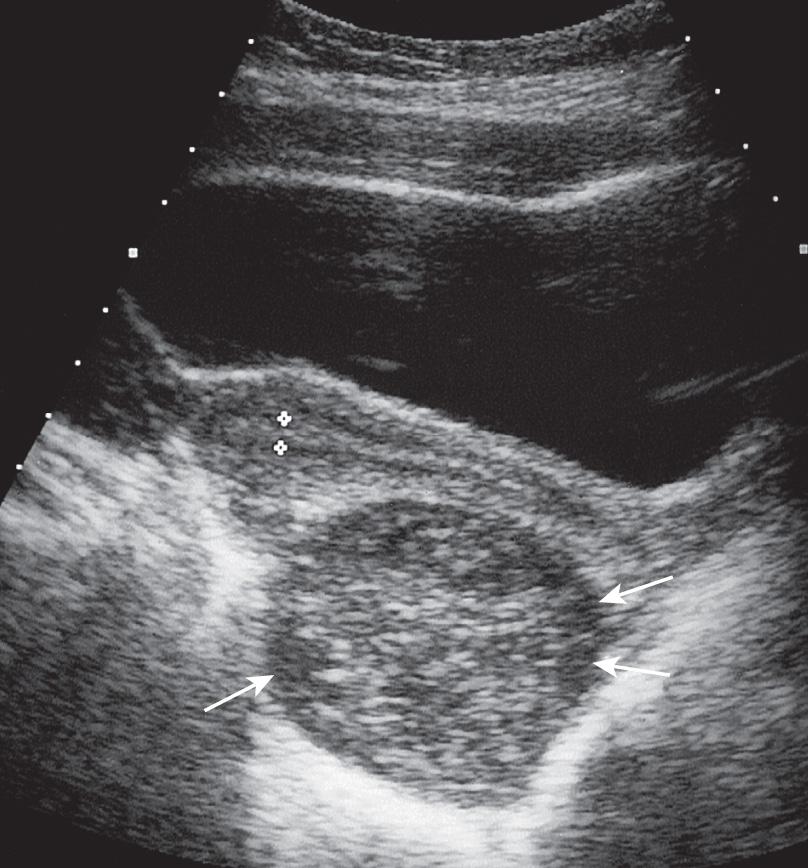
Ovarian neoplasms account for 1% of all childhood tumors, and 10% to 30% of these are malignant. These neoplasms may develop at any age but most frequently occur at puberty. Abdominal pain or a palpable abdominal or pelvic mass is the usual presenting symptom. Symptoms may develop as a result of torsion or hemorrhage into the tumor. Ovarian torsion is more common in adolescents than in adults; however, ascites is less common in girls.
Primary ovarian tumors can be classified into three types of cell origins: germ cells, epithelial cells, and stromal cells. In children, 60% of primary ovarian tumors are of germ cell origin, in contrast to adults, in whom 90% are epithelial in origin. About 75% to 95% of germ cell tumors in childhood are benign teratomas. However, there is a higher incidence of malignancy in younger patients. In girls younger than 10 years, 84% of ovarian germ cell tumors are malignant. The presence of ascites suggests malignancy.
Benign ovarian teratomas (almost 60%)
Dysgerminoma
Embryonal carcinoma
Endodermal sinus tumor
Epithelial tumors of ovary (postpuberty)
Granulosa theca cell tumor (precocious puberty)
Arrhenoblastoma (rare, virilizing)
Gonadoblastoma (in dysplastic gonads—e.g., Turner syndrome)
Acute leukemia
Benign teratomas have a wide spectrum of sonographic characteristics ( Fig. 54.16 ). Teratomas may be predominantly cystic. The most common sonographic appearance is a cystic mass with an echogenic mural nodule, the so-called “Rokitansky nodule” or “dermoid plug.” Cystic teratomas are usually freely mobile on a pedicle; 10% are bilateral, and 90% are less than 15 cm in diameter.

Dysgerminoma is the most common malignant germ cell tumor of the ovary in childhood. This tumor frequently occurs before puberty, and 10% are bilateral. The tumor is usually a large, solid, encapsulated, rapidly growing mass containing hypoechoic areas as a result of hemorrhage, necrosis, and cystic degeneration. Retroperitoneal lymph node metastases may occur. Dysgerminoma is more radiosensitive than the other malignant ovarian tumors.
Embryonal carcinoma and endodermal sinus tumors are less common malignant germ cell tumors. Choriocarcinoma is rare in children. All these are rapidly growing, highly malignant, solid neoplasms. Embryonal carcinoma is often associated with abnormal hormonal stimulation. These tumors tend to spread by direct extension to the opposite adnexa and retroperitoneal lymph nodes. Peritoneal seeding and hematogenous metastases to liver, lung, bone, and mediastinum are common.
Epithelial tumors of the ovary, which include serous and mucinous cystadenoma or cystadenocarcinoma, represent 20% of ovarian tumors in children. Epithelial lesions are rare before puberty. On sonography, they are predominantly cystic masses with septa of variable thickness. It is often difficult to differentiate benign from malignant and serous from mucinous cystadenomas or cystadenocarcinomas based only on sonographic criteria.
Granulosa theca cell tumor is the most common stromal tumor in children. It is often associated with feminizing effects and precocious puberty as a result of estrogen production. Of these tumors, 10% are bilateral; only 3% are malignant. Sonographic appearance is nonspecific, and they may be solid, cystic, or mixed. Arrhenoblastoma (Sertoli-Leydig cell tumor) is rare but may result in virilization. Gonadoblastoma is composed of germ cells admixed with sex cell and stromal elements and usually arises in dysplastic gonads. Bilateral involvement occurs in one-third of cases, and 50% contain dysgerminoma elements.
In leukemic infiltration, the ovaries, as well as the testes and central nervous system, are sanctuary sites for acute leukemia. Ovarian involvement in autopsy series ranges from 11% to 50%. In leukemia with ovarian relapse, most patients have large, hypoechoic, pelvic masses with smooth, lobulated margins. The tumor can infiltrate the pelvic organs and bowel loops to such a degree that the uterus and ovaries cannot be separately identified. Secondary hydronephrosis may develop. Bickers and colleagues suggested that pelvic sonography should be used to monitor and detect early leukemic relapse in the ovaries of children in clinical remission. The ovaries may also be a site for metastatic spread from neuroblastoma, lymphoma, and colon carcinoma. The tumors rarely grow large enough to produce a mass and are usually asymptomatic. Typically, the secondary neoplasms appear on sonography as enlargement of one or both ovaries, which are hypoechoic or hyperechoic to the uterus. Less often, a discrete solid or complex mass is seen.
It was originally thought that Doppler sonography would serve to differentiate between benign and malignant ovarian masses. In adolescents and adult women, malignant ovarian tumors generally have central, low-resistance arterial Doppler waveforms (resistive index [RI] < 0.4, or pulsatility index [PI] < 1.0), thought to be caused by a relative paucity of a muscular layer in the neoplastic vessels, thereby limiting the specificity of Doppler imaging. Benign ovarian masses tend to have peripheral, high-resistance flow (RI > .7 or PI > 1.0). However, nonneoplastic lesions (e.g., tubo-ovarian abscess, ectopic pregnancy, functioning corpus luteum) also have low-resistance flow, and some malignant tumors show high-resistance flow.
Congenital anomalies of the uterus and vagina in children are uncommon and usually manifest as an abdominal or pelvic mass secondary to obstruction. There is a high incidence of associated renal anomalies (50%) and an increased incidence of skeletal anomalies (12%). The uterus, cervix, and upper two-thirds of the vagina are formed by the fused caudal ends of the müllerian (paramesonephric) duct. The paired fallopian tubes are formed by the unfused upper ends. The lower third of the vagina is derived from the urogenital sinus. Müllerian duct development into the uterus is dependent on the formation of the wolffian (mesonephric) duct. Therefore abnormal development of the müllerian duct, resulting in uterine and vaginal anomalies, is often associated with renal anomalies.
The bicornuate uterus is the most common congenital uterine anomaly. It results when the two müllerian ducts fuse only inferiorly ( Fig. 54.17 ). The two separate uterine horns, which are joined at a variable level above the cervix, are best demonstrated on transverse sonograms through the superior portion of the uterus. Most often only one cervix is visualized (when there are two, this is a bicornis bicollis) and one vagina is identified. With complete duplication of the müllerian ducts (didelphys), there is a septated vagina and duplicated cervix and uterus. In either anomaly, obstruction of one uterine horn can result in a pelvic mass from unilateral hydrometra or hematometra. Other septation anomalies of the uterus can result from incomplete involution of the midline septum between the paired müllerian ducts. A unicornuate uterus is formed from the agenesis of one müllerian duct. In utero exposure to diethylstilbestrol (DES) has been associated with development of a -shaped uterus. Sonography shows a narrow uterus caused by absence of the normal, superior, bulbous expansion of the uterine fundus. Three-dimensional sonography is an excellent modality for obtaining planar reformatted sections through the uterus, which allows for precise evaluation of the anatomy.
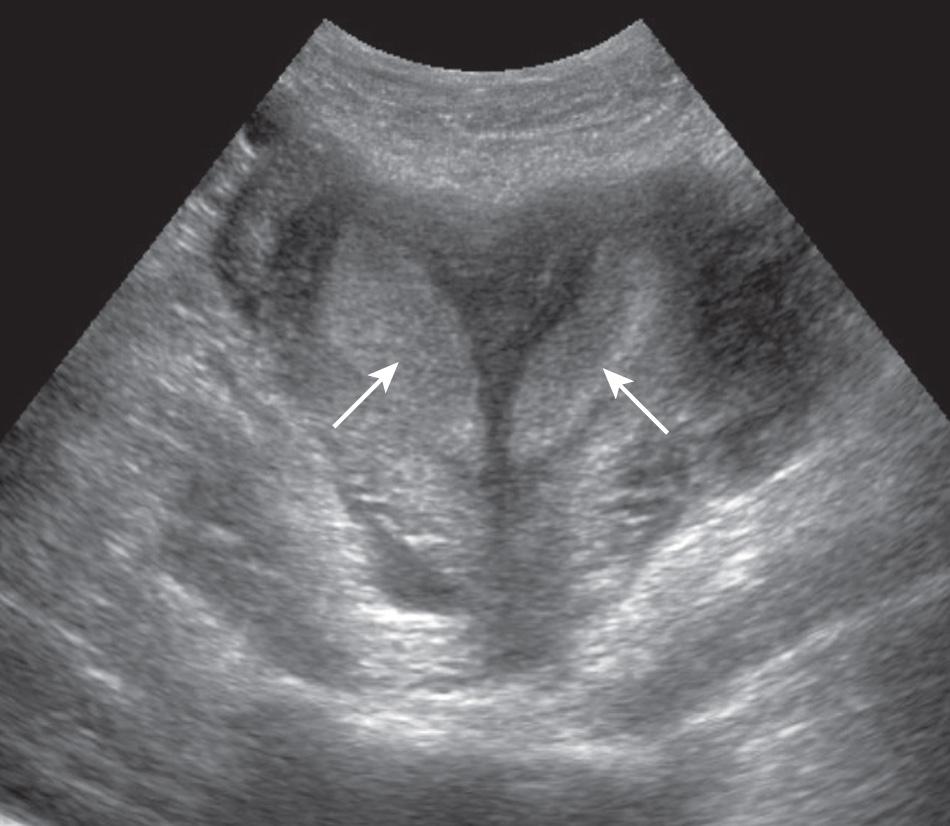
Hydrocolpos or hydrometrocolpos, caused by obstruction of the vagina, accounts for 15% of abdominal masses in newborn girls ( Fig. 54.18 ). The obstruction is secondary to an imperforate hymen, a transverse vaginal septum, or a stenotic or atretic vagina. There is an accumulation of mucous secretions proximal to the obstruction. The secretions are secondary to intrauterine and postnatal stimulation of uterine and cervical glands by maternal estrogens. A simple imperforate hymen is not usually associated with other congenital anomalies. However, there is a high incidence of genitourinary, gastrointestinal, and skeletal anomalies associated with vaginal atresia or a midtransverse or high-transverse vaginal septum. Combined perineal-abdominal sonography is an excellent method for accurate assessment of these anomalies. Although TAS is useful to determine if hydrocolpos or hydrometrocolpos is present, this method does not allow measurement of the thickness of a caudally placed obstructive septum. On sonographic examination, hydrocolpos appears as a large, tubular, cystic mass posterior to the bladder and extending inferior to the symphysis pubis. Low-level echoes within the fluid represent mucous secretions in neonates and blood in postpubertal girls ( Fig. 54.19 ). There may be secondary urinary retention and hydronephrosis. Imperforate anus, cloacal exstrophy, and persistent urogenital sinus often have associated hydrometrocolpos. Rarely, one may see peritoneal calcifications complicating hydrometrocolpos because of a sterile inflammatory reaction to spillage into the peritoneal cavity of accumulated secretions.
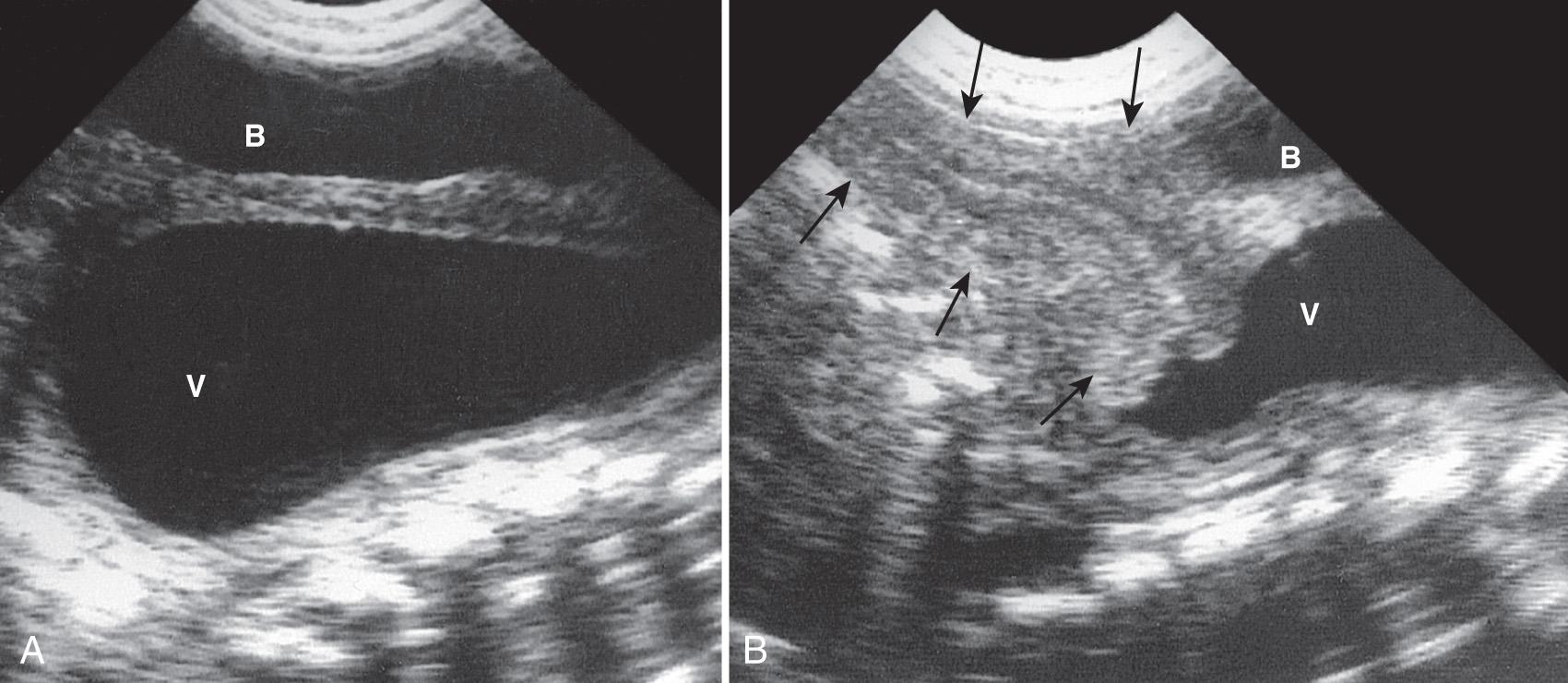

The Mayer-Rokitansky-Küster-Hauser syndrome, the second most common cause of primary amenorrhea, comprises vaginal atresia, rudimentary uterus, normal fallopian tubes and ovaries, and broad and round ligaments. The spectrum of uterine anomalies (hypoplasia or duplication) ranges from a partial lumen to a septate or bicornuate uterus with unilateral or bilateral obstruction. These girls have a normal female karyotype, secondary sexual development, and external genitalia. There are high incidences of unilateral renal (50%) and skeletal (12%) anomalies. Unilateral renal agenesis and ectopia are the most common renal anomalies. The most common sonographic findings are uterine didelphys with unilateral hydrometrocolpos and ipsilateral renal agenesis. Water vaginography can help identify the septated vagina with unilateral vaginal obstruction ( Fig. 54.20 ). The analogous genitourinary defects in the male result in duplicated müllerian duct remnants (müllerian cyst and dilated prostatic utricle) with unilateral renal agenesis.
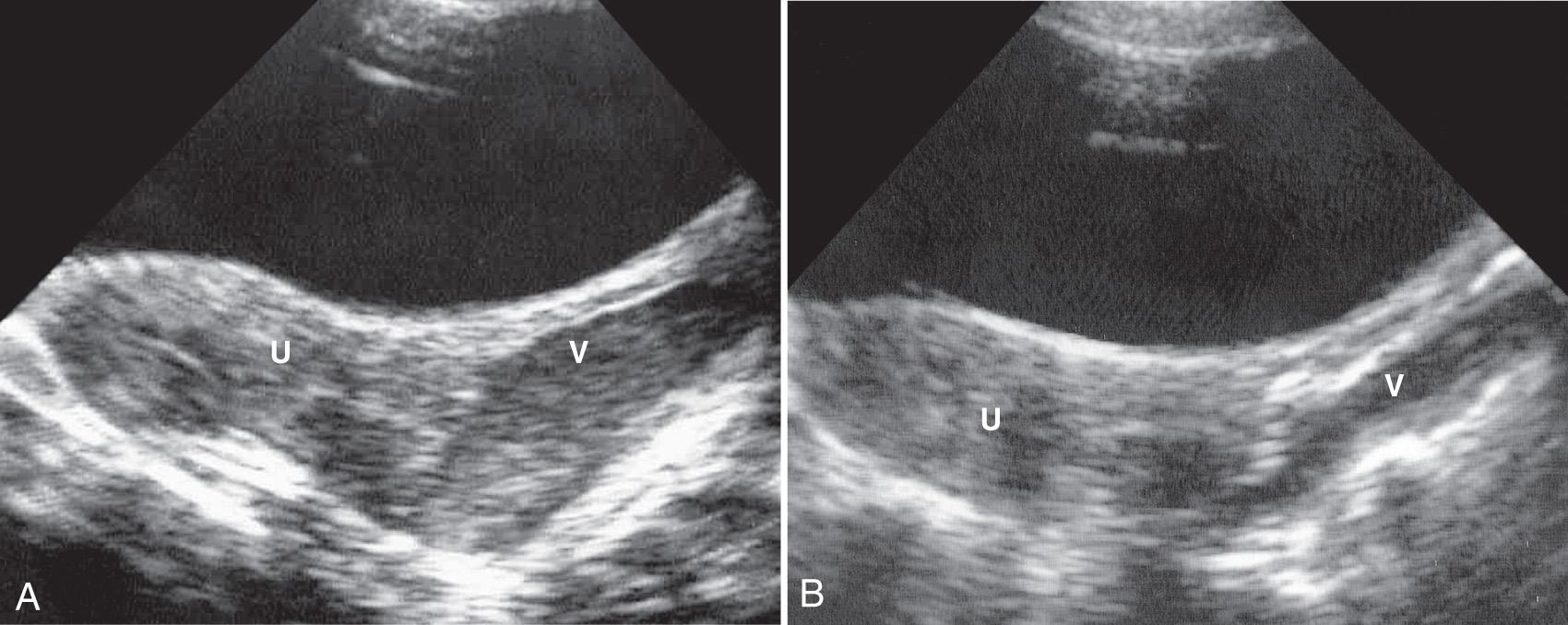
Tumors of the uterus and vagina are uncommon in the pediatric patient. Malignant tumors are more common than are benign tumors, and the vagina is a more common site than is the uterus. Rhabdomyosarcoma is the most common primary malignant neoplasm ( Fig. 54.21 ). It can arise from the uterus or vagina, although uterine involvement is more frequent by direct extension from a vaginal tumor. Presentation is usually at 6 to 18 months of age with vaginal bleeding or protrusion of a polypoid cluster of masses (sarcoma botryoides) through the introitus. Rhabdomyosarcoma most often arises from the anterior wall of the vagina near the cervix. It may also arise in the distal vagina or labia. Direct extension of the tumor into the bladder neck is common, but posterior invasion of the rectum is infrequent. Lymphadenopathy and distant metastases are uncommon at presentation. On sonographic examination, these tumors are solid, homogeneous masses that fill the vaginal cavity or cause enlargement of the uterus with an irregular contour.
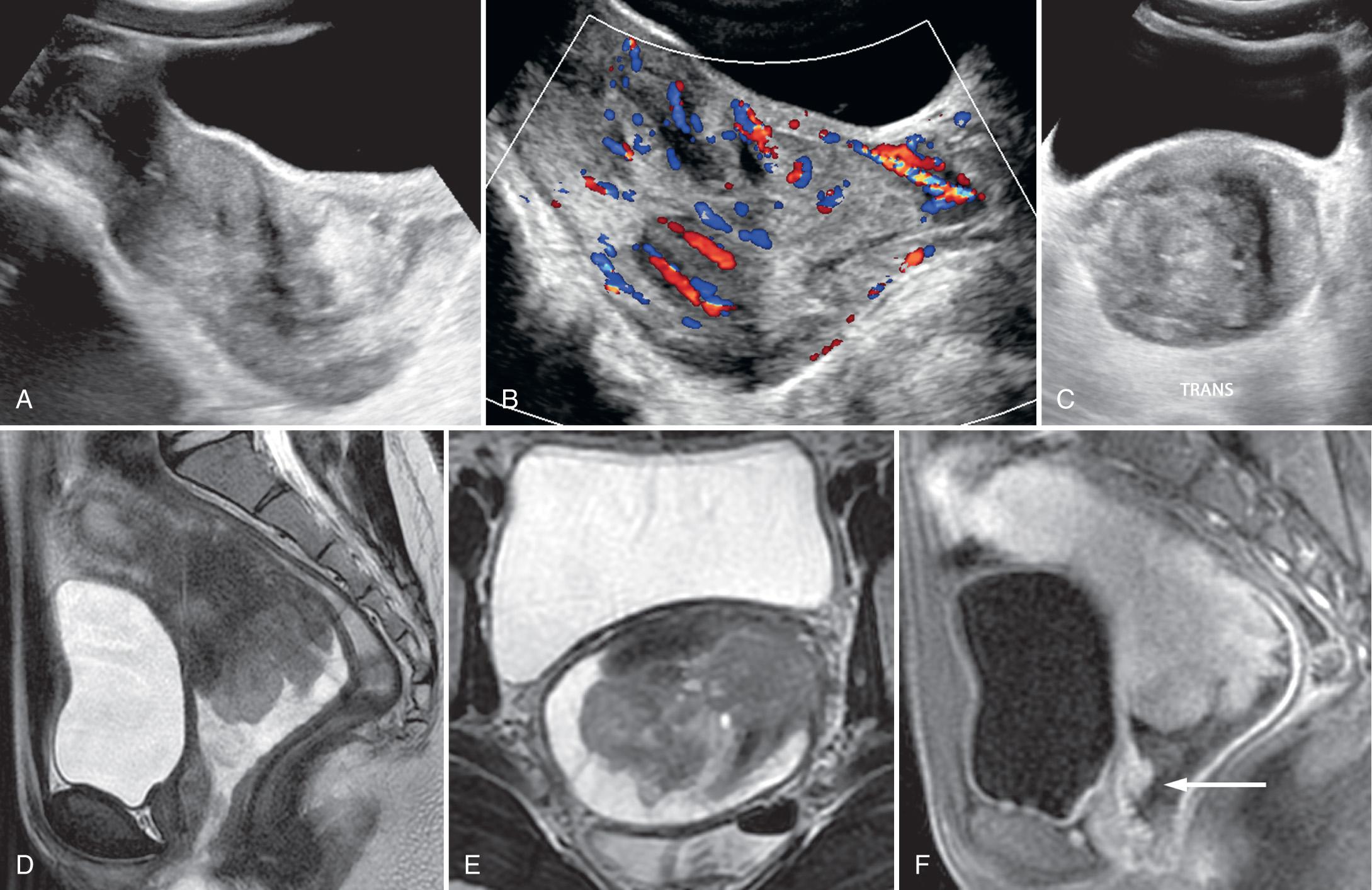
Endodermal sinus tumor, a less common genital neoplasm, is a highly malignant germ cell tumor that can arise in the vagina. It has clinical and sonographic presentations similar to those of rhabdomyosarcoma Other malignant tumors of the uterus and vagina are rare. Adenocarcinoma of the cervix in adults arises from the endocervix, whereas in children it is a polypoid lesion that originates from the ectocervix and upper vagina. Carcinoma of the vagina (usually clear cell adenocarcinoma) usually occurs in teenagers with a history of in utero DES exposure. Leukemic infiltration of the uterus can occur secondary to contiguous extension from an ovarian relapse. Sonography shows a large, homogeneous, hypoechoic, pelvic mass incorporating the uterus and ovaries, which cannot be separately identified. There may be associated hydronephrosis caused by distal ureteral obstruction.
Benign, solid neoplasms of the uterus and vagina are rare in children. However, benign cystic vaginal masses can occur. The most common cystic lesion of the vagina is Gartner cyst. A remnant of the distal wolffian (mesonephric) duct, Gartner cysts may be single or multiple and typically arise from the anterolateral vaginal wall. They appear as fluid-filled cysts within the vagina on ultrasound. Other cystic vaginal masses include paraurethral cysts, inclusion cysts, and paramesonephric (müllerian) duct cysts.
Intrauterine pregnancy must always be considered in the differential diagnosis of a pelvic mass in girls 9 years of age or older. There is an increased incidence of complications in pediatric pregnancy. These include toxemia, preeclampsia, placental abruption, lacerations, and cesarean section. Prematurity and perinatal mortality are also increased in infants of teenage mothers.
When the sonographic findings show a distended endometrial cavity in a sexually active girl, molar pregnancy should be considered ( Fig. 54.22 ). In girls postpartum, a well-defined, heterogeneous endometrial mass raises the possibility of retained products of conception ( Fig. 54.23 ).
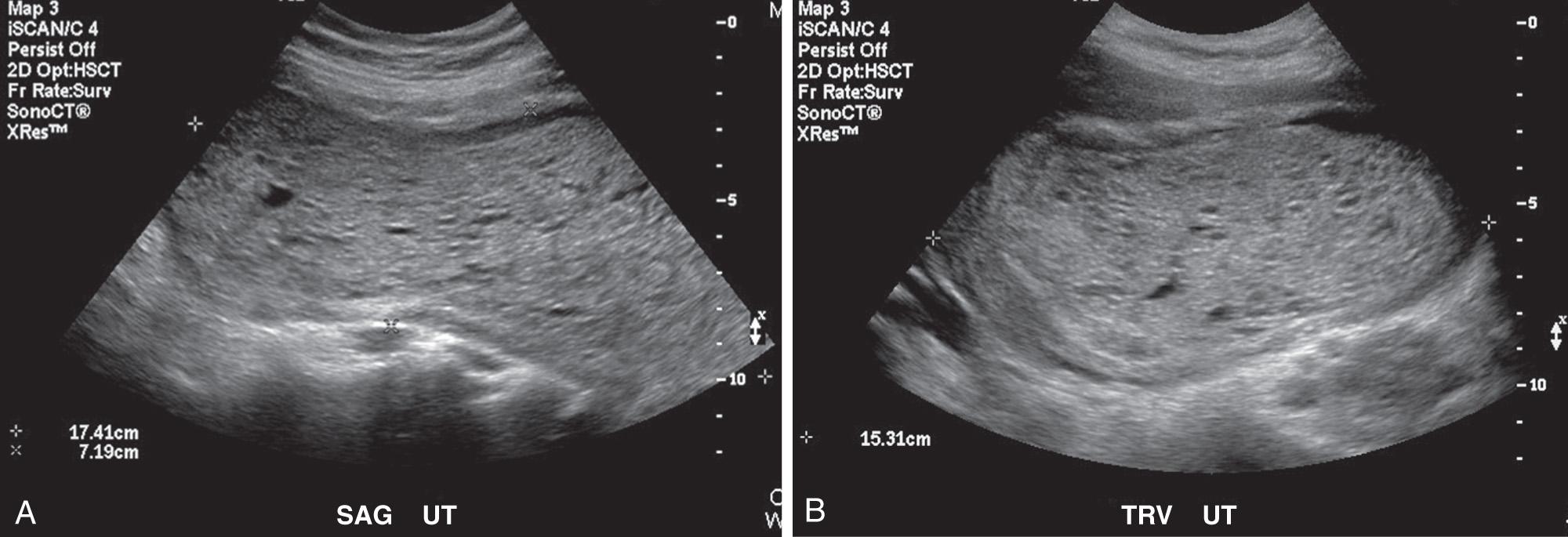
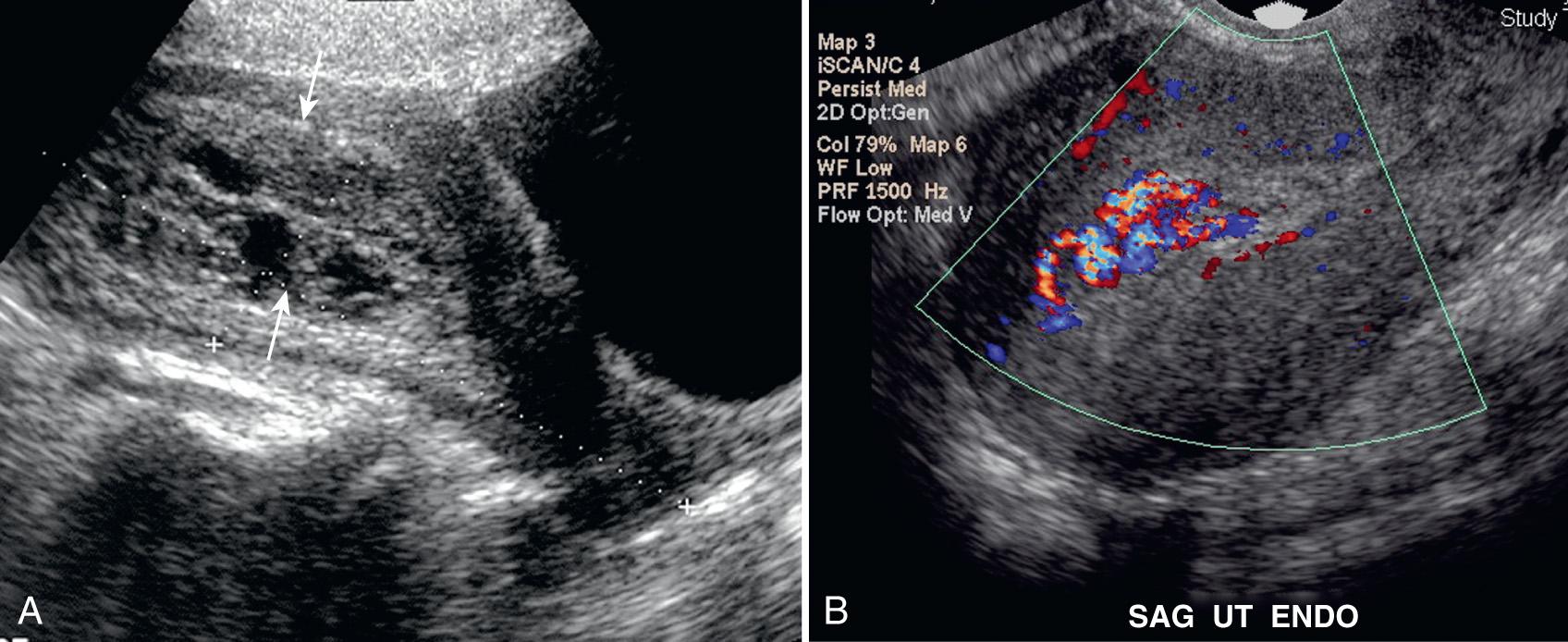
Although ectopic pregnancy accounts for approximately 2% of all pregnancies and is less common in young adolescents, the diagnosis should be considered in the presence of pelvic pain, an abnormal beta human chorionic gonadotropin (β-hCG) level, irregular vaginal bleeding, and missed menstrual period. An ectopic pregnancy is most likely located in a fallopian tube (ampulla 70%, isthmus 12%, fimbria 11.1%). The two most common sonographic signs of ectopic pregnancy include an adnexal mass that is separate from the ovary and the tubal ring sign ( Fig. 54.24 ). The diagnosis is more certain when a yolk sac or a living embryo is demonstrated within the adnexal mass. The tubal ring sign consists of a hyperechoic ring surrounding an extrauterine gestational sac. The additional demonstration of the “ring of fire” sign, which consists of high-velocity, low-impedance flow within the hyperechoic ring, may be another useful finding. However, this sign is nonspecific and may be seen surrounding a normal corpus luteal cyst. Hypotension or overt shock suggests ruptured ectopic pregnancy. Although TVS has greatly improved the diagnostic evaluation of suspected ectopic pregnancy, TAS plays a complementary role by providing a global view of the pelvis and abdominal contents. β-hCG measurements are essential for establishing the diagnosis. This glycoprotein hormone begins to increase in a curvilinear fashion early in pregnancy and continues to increase until approximately 9 to 11 weeks, when it normally reaches a plateau. The plateau lasts for a few days and declines at 20 weeks. β-hCG level doubles on an average of approximately 48 hours when the pregnancy is normal. In the presence of an ectopic pregnancy, however, serum β-hCG levels often rise much more slowly, and a plateau is reached early in the pregnancy. A less than 50% increase in β-hCG level in a 48-hour period is almost always associated with a nonviable pregnancy, whether intrauterine or extrauterine.
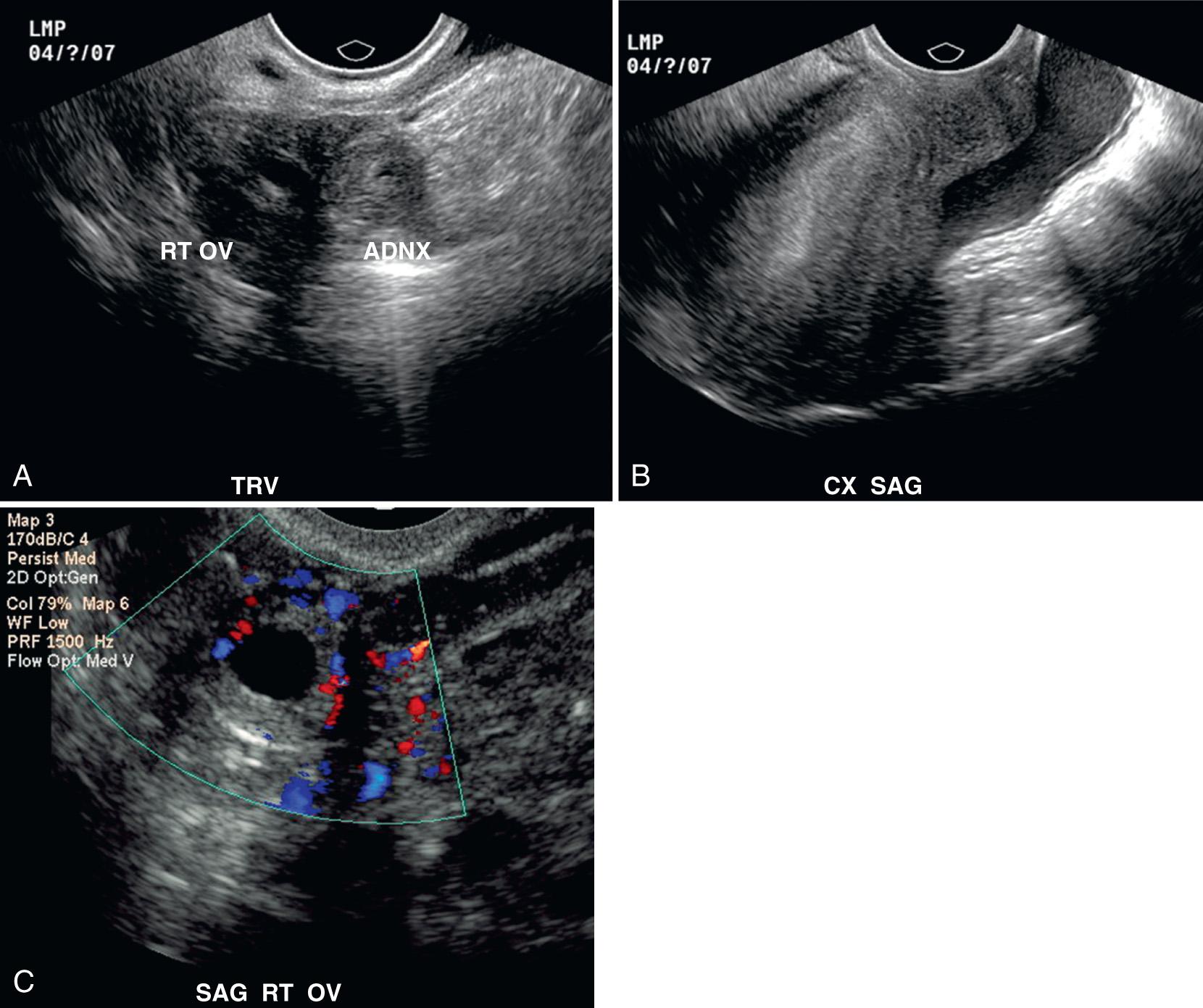
Become a Clinical Tree membership for Full access and enjoy Unlimited articles
If you are a member. Log in here